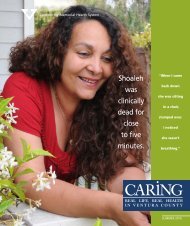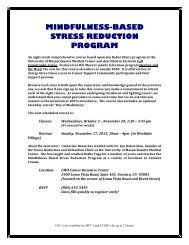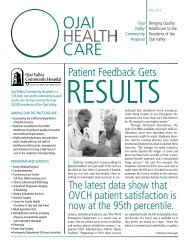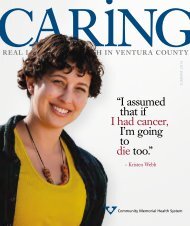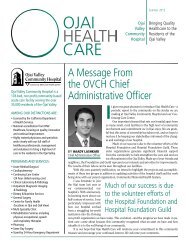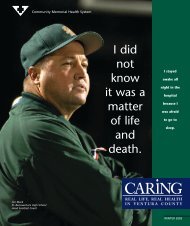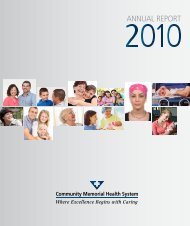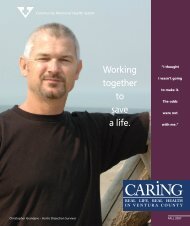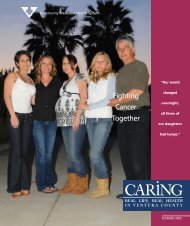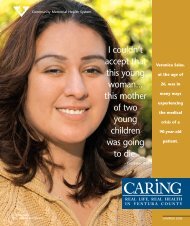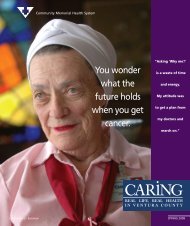It's personal - Community Memorial Health System
It's personal - Community Memorial Health System
It's personal - Community Memorial Health System
You also want an ePaper? Increase the reach of your titles
YUMPU automatically turns print PDFs into web optimized ePapers that Google loves.
CMH is the lifebloodThe new <strong>Community</strong> <strong>Memorial</strong> Hospitalwill feature the latest technologies andcomforts, including all private rooms for everypatient, and be designed to incorporatenew medical frontiers and equipment as theyarrive. Importantly, the perfect hole in theground today will soon feature over 2,200cement pylons reaching nearly 60 feet deep intothe bedrock below to create the foundation fromwhich the new community cornerstone willmajestically rise.In truth, these underground pylons alsorepresent a historical foundation that reachesback 110 years to 1901 when Dr. Cephas Bardcreated the first private hospital in VenturaCounty. Located at the corner of Poli and Firstreets and originally christened Elizabeth Bard<strong>Memorial</strong> Hospital after his deceased mother,in that horse-and buggy-age it was modernisticwith surgical and emergency facilities.Through one site relocation and four namechanges – Bard Hospital became Big SistersHospital in 1923; Hospital de Buena Venturaat the present location in 1931; Foster Memo-rial Hospital in 1933; and finally <strong>Community</strong><strong>Memorial</strong> Hospital in 1962 – its guidingmission has remained as reliable as the NorthStar: provide the highest quality healthcarepossible for Ventura County residents.The scope of <strong>Community</strong> <strong>Memorial</strong> Hospital’sproud legacy to our community is impossibleto measure or properly articulate. Perhapsthe best that can be done is to share what CMHhas meant to one person – and then imaginethe wondrous tapestry that is formed when thethreads of every other life that has similarly beentouched, changed or saved are woven into it.Let me share my own life thread and howit has been positively affected, and greatly, by<strong>Community</strong> <strong>Memorial</strong> Hospital.Except for a five-year span, I have lived inVentura since 1972 when my father, Dr. JamesWoodburn II, moved our family here from Ohioand joined <strong>Community</strong> <strong>Memorial</strong> Hospital’smedical staff as a general surgeon; he remainsactive in the Operating Room to this day. In themid-1980s, my two older brothers – the aforementionedJim, and Doug – also both joinedCMH as general surgeons. All three have servedas Chief of Staff. I am proud of their combinedcontributions as both physicians and leaders, andhave been pleased to write some feature storiesfor this magazine in recent years chronicling thecontributions of others who epitomize <strong>Community</strong><strong>Memorial</strong> <strong>Health</strong> <strong>System</strong>’s motto: “WhereExcellence Begins With Caring.”In this issue, my assignment was: “Whatdoes CMH mean to me?”The simple answer is: Peace of mind. I likeknowing that <strong>Community</strong> <strong>Memorial</strong> Hospitalhas the highly trained personnel and the newesttechnology to expertly treat almost any andevery medical condition and emergency. (Moreover,in the rare event where super specializedtreatment is required, CMH has established relationshipswith larger institutions to facilitate asmooth and speedy patient transfer.)CMH is where my wife gave birth to ourson, who was born three weeks prematurelyand received skillful treatment for jaundice beforecoming home three days later on Christmasmorning. It is where he had a leg fracture put in aCOMMUNITY MEMORIAL HEALTH SYSTEM | CARING 5
continue to be able to receive the latest andgreatest healthcare possible right here inVentura. Also, I like imagining that my futuregrandchildren, grandnieces and grandnephewsmight be born–and later receive the highestquality healthcare–in the new <strong>Community</strong><strong>Memorial</strong> Hospital.Additionally, my wife and I, my brothersand sister, my friends and neighbors, will be partof the aging Baby Boom generation that will oneday likely receive leading edge geriatric care inthe new <strong>Community</strong> <strong>Memorial</strong> Hospital. Indeed,the new CMH is being built with the comingdecades in mind to be able to grow and adopt futuretechnologies in order to expertly care for mydaughter and son when they are senior citizens.For more than a century, investing in expansionas well as new technologies has been a hallmarkof <strong>Community</strong> <strong>Memorial</strong> Hospital–alwaysof Our <strong>Community</strong>The scopeof <strong>Community</strong><strong>Memorial</strong>Hospital’sproud legacyto ourcommunityis impossibleto measureor properlyarticulate.cast at age 3, a broken wrist set a few years later,and a hip stress fracture diagnosed with state-ofthe-artimaging and treated last year at age 20.CMH is where my daughter had masterfulorthopedic leg surgery as a teen; and at age 22spent Valentine’s Day night in the EmergencyDepartment getting stitches in her forehead anda high-tech CT Scan to rule out serious injury aftertripping and falling headfirst into a knee-highbrick wall. As I said, peace of mind.CMH is where I had two separate and successfulsurgeries for entrapped nerves that hadtemporarily paralyzed both thumbs and fourfingers; had laser surgery to remove a kidneystone; and eight years ago underwent a delicatetwo-hour cervical discectomy-and-fusion aftersuffering a ruptured disk between my fifth andsixth vertebrae when a drunk driver speeding 65miles per hour on a city street rear-ended me ata stop sign.CMH is where my father had his gallbladderremoved, and had two high-tech proceduresin the Cath Lab to put in cardiac stents. It iswhere my two older brothers and younger sisterhave been patients; where my nieces and nephewswere born; where my friends, co-workers,and neighbors have been cared for.Now comes the time to reframe the essayquestion to this: What WILL the NEW <strong>Community</strong><strong>Memorial</strong> Hospital mean to me?Again, the simple answer is peace ofmind. I like knowing that my family today willat crucial junctures with the help of key communitymembers. Indeed, in its past incarnationsas Elizabeth Bard <strong>Memorial</strong> Hospital, Big SistersHospital, Hospital de Buena Ventura, Foster<strong>Memorial</strong> Hospital, and today’s <strong>Community</strong><strong>Memorial</strong> Hospital, generous individuals havemade all the difference. Eugene P. Foster, GeorgePower, Fritz Huntsinger, Sr., and Ida Goodyear,to name but four farsighted benefactors, whostepped forward in times of great need.Goodyear, for example, not only led a fundraisingdrive to build a new maternity wing in1946 to handle the baby boom following WorldWar II, she made the largest donation to theproject: $130,000. Her legacy lives on to this daywith <strong>Community</strong> <strong>Memorial</strong> Hospital’s stature asthe preeminent birth center in the county.Huntsinger’s selfless legacy includes writinga $1-million check in 1963 to build a cutting-edgecardiac catheterization lab; and in 1974 donating$500,000 to purchase an EMI-scanner that madeCMH the first hospital west of the Mississippito have this ground-breaking technology for diagnosingbrain disorders such as tumors, strokesand blood clots.Foster, meanwhile, donated the land at thecurrent <strong>Community</strong> <strong>Memorial</strong> Hospital campusto build a new facility in 1929 when the originalBard Hospital, then called Big Sisters Hospital,had become too small and outdated despite theaddition of an annex. What is more, Foster feltso strongly the community absolutely needed a6 CARING | COMMUNITY MEMORIAL HEALTH SYSTEM
larger and more modern hospital, that he andGeorge Power <strong>personal</strong>ly pledged to cover anyshortfall between public donations and the projected$250,000 construction cost. They madegood on their promise.Building a new not-for-profit <strong>Community</strong><strong>Memorial</strong> Hospital is an especially daunting undertakingin today’s difficult economic times.Remember, however, that the hospital Fosterhelped make a reality came during even moredire fiscal times: the Great Depression. Despitethis challenge, on January 1, 1931, Hospital deBuena Ventura – complete with a modern X-raymachine – opened. One year later, following thegreat philanthropist’s death, it was renamed Foster<strong>Memorial</strong> Hospital, a name it retained until becoming<strong>Community</strong> <strong>Memorial</strong> Hospital in 1962.Now, once more, a pivotal crossroads hasbeen reached where an avant-garde medicalfacility is needed. California’s more stringentseismic standards approaching on the horizonprecipitated the building of the new <strong>Community</strong><strong>Memorial</strong> Hospital, but in truth it is dearly neededanyway in order to meet increasing patientdemand and future advances in medical technologiesin all fields at CMH, including heartand vascular, neurosurgery, urology, oncology,radiology, gynecology, orthopedics, general surgery,ICU, CCU, Neonatal Intensive Care Unit,imaging, maternal child health, pediatrics, andthe emergency department.When I look at the construction site for thenew <strong>Community</strong> <strong>Memorial</strong> Hospital, I see morethan a hole in the ground – I see a hole that isspecial because it must be. Indeed, from it willrise not just a new hospital scheduled to openin March 2015, but our new vanguard hospitalwhere our families and our neighbors will be expertlycared for – by healthcare experts who arealso family and neighbors living in our community.It is said that a house is made of brick andmortar, but a home is made by the people wholive there. Similarly, a hospital is made of brickand mortar, but <strong>Community</strong> <strong>Memorial</strong> Hospital– past, present and future – is made by thephysicians, nurses, technicians and other dedicatedemployees who work inside.It is only human nature that when we arehealthy we do not often think about our hospital.But when an accident causes injury, when chestpains strike after dinner or labor contractionsbegin in the middle of the night, when we or aloved one needs to be mended, cured and caredfor, <strong>Community</strong> <strong>Memorial</strong> Hospital is a lifebloodalways there to serve us.Hippocrates once stated: “Cure sometimes,treat often, comfort always.” His words perfectlydescribe what <strong>Community</strong> <strong>Memorial</strong> Hospitalmeans to me.ABOUTWOODY<strong>Community</strong> <strong>Memorial</strong> Hospital’s commitment to being part of the communityby caring for our fellow citizens, neighbors, co-workers and family membersis exemplified by Woody Woodburn, making him the ideal person to write our coverstory for this special edition of CARING Magazine.Indeed, Woody represents a wide spectrum of people in our community whoselives are touched by CMH.To begin, Woody grew up in Ventura and has been a community member fornearly four decades. Moreover, thanks to his award-winning sports columns at theVentura County Star for a dozen years and now through his Opinion Page generalinterestcolumn every Saturday, many residents throughout the County feel theyknow him as a “friend” or “neighbor.” CMHS is also proud to have him as ourprincipal writer for CARING Magazine.While CMH’s physicians, nurses and staff strive to take care of patients as ifthey were their own family, Woody has literally been cared for at CMH by family: hisfather, Dr. James Woodburn II, and two older brothers, Drs. James and Douglas, areall surgeons on the medical staff.Woody’s wife, Lisa, has been a patient at CMH as has the couple’s 24-year-olddaughter, Dallas, and 21-year-old son, Greg, who was also born at CMH.“Like so many people in our community, I am very thankful to CMH and feel areal connection to it,” Woody says. “It’s hard to imagine anyone who lives here whohas more than one degree of separation from CMH: if they haven’t been cared forat the Hospital, one of their family members, friends or co-workers has.”Or perhaps they’ve read newspaper columns by a writer who has.Make aDifferenceJoin the Auxiliary<strong>Community</strong> <strong>Memorial</strong> Hospital: 805/652-5043Ojai Valley <strong>Community</strong> Hospital: 805/646-1401COMMUNITY MEMORIAL HEALTH SYSTEM | CARING 7
Disaster Management SteeringCommittee Member Ed Pulido FindsHimself a First Responder After theTornado Hit Joplin, Missouri on May 22.NOSTRANGERTO8 CARING | COMMUNITY MEMORIAL HEALTH SYSTEM
to an all-digital format first took root at CMH in2001 when the hospital began converting a fewof the records found in a patient’s medical chart.Still, doctors kept much of the information filedaway in the unmistakable folders that crowdfront offices throughout CMHS and the privatepractices around town.He said CMHS is motivated to meet theFederal 2015 deadline not only because it comeswith cash back incentives for those who do—orcuts to Medicare and Medi-Cal reimbursementsfor those who don’t – but also because it’s thecompletion date for the new <strong>Community</strong> <strong>Memorial</strong>Hospital in Ventura.CMHS has decided to roll out the newsoftware program slow and steady, continuallyadding doctors to the system in the comingmonths. At present, Frochtzwajg is one of fourphysician offices encompassing twelve doctorsusing Allscripts as part of a pilot program.In addition to <strong>Community</strong> <strong>Memorial</strong>Hospital, digital medical records will also beused at Ojai Valley <strong>Community</strong> Hospital, andour eleven clinics.Sandifer said he expects to see more than100 doctors on the system by the end of the year.To help connect the CMHS software withthe other medical record programs used by agrowing number of private practices in VenturaCounty and other hospitals, Sandifer said CMHis installing a <strong>Health</strong> Information Exchange programcalled dbMotion, software created by anIsrael-based tech firm that allows doctors to readreports created on different computer programs.Sandifer said there is a growing numberof local private practices who’ve heard aboutAllscripts and want to become integrated intothe hospital’s system. It’s a job that will take aninvestment in time, money and patience.He said althoughCMHS is working todefray some of the costslocal private practiceswill incur transitioningto Allscripts, federal lawprohibits a hospital fromfinancing more than 85percent of the program’stotal costs.The gap, Sandifersaid, can come with ahefty price tag. A privatepractice has to pay amonthly license fee toCMHS for the software, purchase their ownoffice printer, computers and internal networkto access the Allscripts software. It can alsorequire an outside consultant, depending onthe requirements of the physician office duringthe implementation of the program. Duringthe initial weeks of go-live doctors need to seefewer patients until they and their staff are morecomfortable with the software.Despite the initial sacrifices, Frochtzwajgsaid he has begun to see a “real return on investment,”thanks to the new program.Frochtzwajg said his staff has becomemore efficient. His patients leave his office witha printed copy of what was done and said attheir appointments – which includes the doctor’srecommendations and the medicationprescribed.Most importantly, he said, the informationwill soon be able to be cross referenced byother doctors in the hospital ER departmentand physician offices when a new patient visitstheir office.It’s a prescription for success, Frochtzwajgand Sandifer said, that will go a long way towardcreating a healthier tomorrow for <strong>Community</strong><strong>Memorial</strong> <strong>Health</strong> <strong>System</strong> and the patientsit serves.“The software helps dissolve the old paternalisticapproach to medicine and helps developa collaborative approach to medical care withthe patient, the physician and the healthcaresystem,” he said.COMMUNITY MEMORIAL HEALTH SYSTEM | CARING 11
trainingphysiciansof thefuture<strong>Community</strong> <strong>Memorial</strong> <strong>Health</strong> <strong>System</strong> creates anew education model for building better doctors.A physician shortage is around the corner. Sosays the Association of American Medical Colleges,predicting current graduation and trainingrates could leave the nation facing a shortfall of150,000 doctors in the next 15 years.While a number of medical schools haveraised their annual enrollments in an effort to easethe coming shortage, the AAMC reports anotherproblem: too few medical residency positionsavailable at hospitals where newly graduated doctorsreceive specialty training.Enter <strong>Community</strong> <strong>Memorial</strong> <strong>Health</strong><strong>System</strong>, which has stepped forward as an activestakeholder in training physicians of the future.In July 2013, <strong>Community</strong> <strong>Memorial</strong> Hospitaland Ojai Valley <strong>Community</strong> Hospital will greettheir first class of incoming residents as part of14 CARING | COMMUNITY MEMORIAL HEALTH SYSTEMCMHS’ new Graduate Medical EducationProgram.“Our vision is to create a multi-specialtyprogram to train a physician workforce capableof providing excellent care within a collaborative,community based environment,” says Erin Quinn,Ph.D., M.Ed., who was hired as AdministrativeDirector of Graduate Medical Education atCMHS in February.Quinn, who served on the CMHS Board ofTrustees for almost four years, brings invaluableexperience and expertise to this leadership position.She has been on the faculty at the Universityof Southern California since 1990, including servingsix years as Associate Dean for Women andthe past 12 years as Associate Dean of Admissionsand Educational Affairs. Quinn, who will remainErin Quinn, Ph.D., M.Ed.Administrative Director of Graduate Medical Educationon the faculty at the Keck School of Medicine,also teaches two courses at USC: “Professionalismin the Practice of Medicine” and “<strong>Health</strong> Policy.”Dr. Samuel Small (Orthopedic Surgeon)has been named Medical Director of GraduateMedicine Education.CMHS’ Graduate Medicine EducationProgram will be affiliated with Western Universityof the <strong>Health</strong> Sciences located in Pomona.Western University has a College of Osteopathic
Medicine, which has a more holistic approach tomedicine and is one of the fastest growing healthprofessions in the U.S. today. There are currently70,000 osteopathic physicians nationwide andmore than 18,000 osteopathic medical students.Osteopathic physicians are fully trained andlicensed to practice in all medical and surgicalspecialties and subspecialties. CMHS’ programwill offer residencies in four specialties: GeneralSurgery, Orthopedic Surgery, Internal Medicine,and Family Medicine. Two to four residents willbe accepted annually in each residency specialty;the length is from three to five years, dependingon the specialty.“We are striving to create a new residencyeducation model that teaches collaborationalong with a holistic view of the patient’s health,”Quinn explains. “We have a very talented staffof physicians at CMHS who already have aholistic and collaborative view in their ownpractices and will become an excellent teachingfaculty. This approach to medicine is importantbecause it not only leads to better care for thepatient, it also helps keep rising costs down.”For example, a stroke patient at a metropolitanteaching hospital might be examined by fiveor six specialists with each ordering their own setof lab tests and scans.“Rather than collaborating with fellowphysicians and sharing information, they arefocused on their own specialty,” Quinn says.“Our philosophy is different. Instead of being ina silo focused completely on an individualspecialty, our goal is to create a learning environmentthat provides breadth with depth ineducation. The result is better doctors – andbetter patient care.”While the inaugural class of 12 residents istwo years off, starting this summer CMH will“Our goal is to create a learning environment thatprovides breadth with depth in education. Theresult is better doctors – and better patient care.”host three fourth-year medical students fromWestern University for “clerkship” rotations.Specifically, two students will spend a month inEmergency Medicine and one student will spendsix weeks in Pediatrics.“It’s a nice way for us to get used to havingstudents here,” Quinn remarked.In truth, for the past four summers CMHhas annually hosted six USC Medical Schoolstudents for one month to teach them aboutpracticing medicine in a community hospitalsetting. The CMHS Graduate Medical EducationProgram will similarly provide invaluable experiencein community healthcare.“Large medical centers that provide transplantsand exist as ivory towers are a small part ofmedicine,” allows Quinn, who has vast experienceat both. “It is important to expose students tohigh-quality community-based medicine.”The residents are not the only beneficiaries.“Our education program will be great forour physicians and our patients and the communityas a whole,” says Quinn. “The physicianshortage is coming, so it’s important to helpgrow our own.”WhyOsteopathy ?American medicine, one of the best in theworld, is at a crossroads. The medical communityis attempting to meet multiple needs, including thedesire for continued research and development ofnew medical technologies, developing solutionsto reduce chronic conditions such as diabetes andhypertension, and grapple with the overwhelmingincrease in the costs of medical care.As we thought about the future of healthcare,we decided to be involved in their training, andbridge the gap between the academic settingand healthcare in the community. In furtherresearching the possibilities, it was clear that theosteopathic teaching model was in line with ourvision of collaborative, cross discipline training,looking at the whole human body, and theinterdependence of all the parts of the humanbody. Osteopathic physicians are trained torecognize the interdependence of all of the partsof the complex human body, and also considerthe patient’s mental and emotional status.As we, as a healthcare organization, developa system which places the patient fi rst, and thehealth of the patient as our goal, we feel that thephilosophy of approaching the human body inits entirety, and not dividing the person intomultiple components, will create the best way tobe a care provider.Looking for a Doctor?Selecting the right physician is a difficult decision and<strong>Community</strong> <strong>Memorial</strong> <strong>Health</strong> <strong>System</strong> is here to help.Physician Referral ServiceCall: (805) 652-5600 orvisit: www.cmhshealth.organd click “Find a Physician.”COMMUNITY MEMORIAL HEALTH SYSTEM | CARING 15
Maddie Charles:The Joy of CaringMMaddie Charles will tell you she was born toplay softball. And on her 11th birthday, she hit ahome run.In a world where most kids have visions ofiPads and Xboxes dancing in their heads, Maddiefocuses on O.R.s and X-rays.The sixth-grader at Walnut Canyon Arts andTechnology Magnet School asked the 60 guestsnot to give her presents during her recent birthdaybash at a Moorpark ball field. Instead she requestedthey donate to a cause Maddie champions: <strong>Community</strong><strong>Memorial</strong> Hospital.“I told them, ‘I have everything I need so Ishould help other people,’” said Maddie, an articulateyoung lady who uses words like “curriculum”and “devastated” in her conversation.So she and her parents set out sandwiches tofeed the guests and a coffee can for donations.Maddie is a natural when it comes to helpingothers, according to her mother, Nellie Charles.“If someone is in need, Maddie is there,” saidNellie, a Fillmore native who gave birth to Maddieand her two younger sons at <strong>Community</strong> Memo-rial Hospital.Maddie has walked her neighborhood collect-ing for Make-A-Wish Foundation, sung to seniorcitizens, sent cards to U.S. troops on duty in theMiddle East and planted trees on Earth Day.She manages all this in addition to playing ontwo softball squads as catcher and tending the goalon a soccer team.She even adopted Taz, a horse whose ownermoved out of state. The owner continues to paythe boarding fees but never visits or grooms theanimal. So Maddie talked her father, Christopher,into hiring a farrier to tend the horse’s hooves.After school, Maddie and her friends bathe andbrush the seemingly grateful Taz.Oh, and then there is Scraps the cat; theneighborhood stray knows there is always a mealat Maddie’s front door.Considering she has taken so many charitablecauses to heart, it took something powerfulto focus Maddie on the work of <strong>Community</strong><strong>Memorial</strong> Hospital.And eight years ago, Nellie’s best friend StacyGraham gave birth prematurely to twins Patrickand Parker. Due to complications, both boys werecared for at <strong>Community</strong> <strong>Memorial</strong> Hospital duringtheir early months of life.“I remember Maddie sitting in the waitingroom, while her mother and I were there,” saidGraham, a Venturan, who herself was born atCMH. “Even as a little girl, she was always soconcerned, so nurturing.”Maddie, though, is awed by the generosityof others. At the party’s end, she counted $463 inthat coffee can.“My friends are so kind-hearted and sweet,”she said, adding that one guest threw in “onehundred bucks.”Her father, Christopher, delivered the moneyto the hospital in the coffee can and expressespride when he describes the reaction of the staff.“A lot of people were blown away that mydaughter gave to the hospital in lieu of gifts,” saidChristopher, a filmmaker.“I told them, I have everything Ineed so I should help other people”“If a little girl could do this, what couldsomeone who has resources do? To Maddie, $463is like a $100,000 to an adult.”For her efforts, Maddie received aninvitation to the Gold Dust Gala, a major fundraiserof the <strong>Community</strong> <strong>Memorial</strong> <strong>Health</strong>careFoundation, which gives uninsured and underinsuredwomen the care they need through theBreast Center at <strong>Community</strong> <strong>Memorial</strong> Hospital.As it turns out, Maddie was the youngestguest at the April benefit. There, she said, she meta woman who told her the cancer treatment shereceived at CMH saved her life.The experience inspired Maddie to find newways to help others, her mom said.Asked what she wants to be when she growsup, Maddie offers a host of thoughtful answers:Peace Corps volunteer, chef and actress.But one thing is for certain. Maddie willforego presents on her next birthday and ask formore donations to CMH.Who knows, maybe next year she could bata thousand. A thousand dollars, that is.16 CARING | COMMUNITY MEMORIAL HEALTH SYSTEM
WoundCareaffected 6.5 million Americans last year,a figure that is expected to continue growing due to a sharp rise in theincidence of diabetes and obesity along with an aging population.Center for Wound Healing& Hyperbaric MedicineThe good news is that Chronic WoundHealing is now a Board Certified specialty andresearch in this emerging field is increasing at anexponential rate.After spending the first 25 years of his medicalcareer in Emergency Medicine, including fiveyears at <strong>Community</strong> <strong>Memorial</strong> Hospital in Ventura,Dr. John Tesman was drawn to the excitingand new disciplines of Chronic Wound Healingand Hyperbaric Medicine. Eight years ago, hebecame board certified and a Fellow in the Collegeof Certified Wound Care Specialists, as wellas board certified in Undersea and HyperbaricMedicine.Coming from the high-energy EmergencyRoom, the pace in the Wound Care Center isslower and less frenetic yet the work they do isevery bit as rewarding. Because they see patientsfor many weeks and even months, they are able todevelop relationships and create a loving familytypeatmosphere while providing closure for theirwounds.Chronic wounds – by definition a wound thathas not healed completely after 4 to 12 weeks – canbe terribly depressing and debilitating. In fact, theysometimes say Dr. Tesman is in the “limb-savingbusiness” because chronic wounds can result inamputation. This is especially true among diabeticpatients as they have a 15 percent increased riskfor amputation than the general population dueto chronic ulcers.By using a multidisciplinary approach, aChronic Wound specialist looks for and addressesthe multitude of factors that cause a wound. Forexample, he can help a diabetic get his diseaseunder control; refer a patient to a smoking cessationclinic; get ancillary care from other medicalspecialists such as a vascular surgeon. The goal isto not only close and heal a wound, but also helpreverse medical conditions that can cause woundsin the future.Approximately 2 percent of the U.S. populationwill experience a chronic wound during theirlifetime. Diabetes is the most common cause ofa chronic wound followed by obesity. Advancingage can also play a contributing role, as do lack ofexercise and poor diet.The most common cause of lower extremitychronic wounds is diabetes, followed by arterialand venous ulcers. Indeed, at the Wound CareCenter they see many different types of woundsranging from pressure ulcers to traumatic ulcers;from compromised flaps and grafts to radiationtissue injuries from cancer treatments.A Chronic Wound healing specialist hasextensive training in treating all of these variouswounds using proven evidence-based medicineand recognized clinical guidelines. Additionally,he or she is knowledgeable about the newestdressings and other sophisticated products toachieve the best, and fastest, results possible.About 25 percent of wound-care patientsare best served by undergoing hyperbaric oxygentherapy as an adjunctive therapeutic treatment.John Tesman, M.D.Medical Director of <strong>Community</strong><strong>Memorial</strong> <strong>Health</strong> <strong>System</strong>’sCenter for Wound Healing &Hyperbaric Medicine Programlocated at 2705 Loma Vista Rd.Suite 205 in Ventura.Patients are placed in a hyperbaric chamberpressurized with 100 percent oxygen, resulting inhugely elevated blood and tissue oxygen concentrationsthat can greatly promote healing.Hyperbarics began decades ago as a wayto treat decompression illness – “the bends” indivers – but today has more than a dozen provenindications, including crush injuries and tissuebreakdown from radiation treatments for cancer.Dr. Tesman is extremely pleased and proudthat <strong>Community</strong> <strong>Memorial</strong> <strong>Health</strong> <strong>System</strong>’snew Center for Wound Healing & HyperbaricMedicine Program features two state-of-the-arthyperbaric chambers because there is a real andgrowing need for this cutting-edge treatment.Indeed, it’s exciting to now be able to offer ourcommunity a full spectrum of specialized chronicwound care right here in Ventura County.COMMUNITY MEMORIAL HEALTH SYSTEM | CARING 17
igotmyiIn the middle of the night 12 summers past,Mark Franek’s world unraveled. At age 47, hesuffered a heart attack that left him in a comafor six days and potentially in need of a hearttransplant.A medical team of experts at <strong>Community</strong><strong>Memorial</strong> Hospital – from Emergency Departmentphysicians and cardiologists to cardiothoracicsurgeon Dr. Lamar Bushnell, who performedquadruple bypass surgery – saved Franek’s life.However, Franek credits the CMH CardiacRehabilitation Department with giving him hislife back.“I would not be here today without theCardiac Care Rehab Program,” the 59-year-oldVentura resident says. “I mean that. They educatedme about my heart and about exercise andnutrition, but they did so much more than that.(Department Director) Mary Miasek – I call her‘Saint Mary’ because she is so caring – and heroutstanding staff gave me confidence and peaceof mind.”In fact, they have done so twice. Indeed,Franek is a two-time “graduate” of the carefullyplanned 10-week program that uses a multidisciplinaryapproach of exercise, education, nutrition,reduction of risk factors, and stress managementclasses to rebuild the body, mind and spirit oflifeback“I would not be here todpatients and their families. The ultimate goal isto help patients who have suffered recent cardiacincidents such as myocardial infarction, cardiacbypass surgery or angioplasty return to theiroptimum quality of life.Franek says he appreciated being monitoredby an EKG the entire time he was exercising ona treadmill or stationary bike. He also has highpraise for the nurses who are specially trainedin cardiology, nutrition, body mechanics, andexercise physiology.“They are so knowledgeable and caring,”Franek says. “They never treated me like anumber – I was Mr. Franek to them. With aheart attack or heart surgery, you lose a lot ofyour dignity and sense of control, but they reallyhelp give it back to you by treating you with thegreatest respect and care.”Franek left the program with new lifestylehabits, including wearing a pedometer with adaily goal of taking 10,000 steps although heproudly notes he usually surpasses 14,000. Healso follows a low-fat Mediterranean/Japanesestylediet rich in vegetables.“For me, the psychologists were crucial,”Franek explains of his challenging road to recovery.“Getting over the mental part of having aheart attack has been much more difficult for me18 CARING | COMMUNITY MEMORIAL HEALTH SYSTEM
“It was more than a yearof work, but the endresult is yet anotherlevel of patient safety.”CMHSSCANSFORPATIESAFE<strong>Community</strong> <strong>Memorial</strong> <strong>Health</strong> <strong>System</strong>continues to use technology to change the worldfor its patients, most recently with the implementationof a state-of-the-art Bedside MedicationVerification (BMV) and electronic MedicationAdministration Record (eMAR) system.More simply put, <strong>Community</strong> <strong>Memorial</strong>Hospital, Ojai Valley <strong>Community</strong> Hospital, aswell as OVCH’s Continuing Care Center, havesuccessfully implemented a new “BMV PatientCare <strong>System</strong>” employing barcode scanning toprevent medication errors.“This is a way to further improve our caringperformance and safety by assuring the Patient’sFive Rights of Safe Medication Administration:Right Patient, Right Medication, Right Dose,Right Time, and Right Route of Delivery,”says Meg Larramendy, RN, CMH Director ofNursing Resources.“It was a Herculean effort,” adds GeneDay, CMH Director of Pharmacy, notingthat this immense project began more than ayear and a half prior to successfully going liveat CMH this past March 1 and at OVCHon April 19.Indeed, among the countless tasks includedin the BMV project was ensuring that everydrug in both Hospitals’ Pharmacies is assigneda unique computer barcode. With more than3,000 different drugs on site, this was indeeda challenge.“It was more than a year of work,” Daysays, “but the end result is yet another level ofpatient safety.”The safety guardrails incorporated into theBMV system are numerous, from identifyingeach patient with a unique barcoded wristbandto securely dispensing medication with a hightechPyxis MedStation <strong>System</strong>.About the size of a photocopy machine,Pyxis can be thought of as a computerizedvending machine for medication – albeit a highlysecure one that requires nurses to log-in witheither fingerprint identification or <strong>personal</strong> password.Furthermore, these newest-generationPyxis MedStations – of which CMH has 20 locatedthroughout the hospital while OVCH andits Continuing Care Center have six – also usebarcode scanning to help ensure patient safety.Each Pyxis cabinet can contain up to300 different drugs, with the contents varyingaccording to the need of the patients it serves.Interface technology allows the CMH andOVCH Pharmacies to monitor the contents inreal time.The “chain of custody” of every drug iscontinually tracked, beginning in the Pharmacyto the Pyxis station; to when a nurse loads it intoa computerized Bedside Mobile Workstation(BMW) cart with a scanner attached; to whenthe medication is administered to the patient atthe bedside.In total, CMHS has invested in 70 stateof-the-artBMW carts with scanners for CMH,OVCH and Ojai’s CCC. For infectious patientswho require isolation, a number of rooms atCMH are fitted with wall-mounted computerswith scanners. Additionally, BMWs are availableto be dedicated to single rooms.Like the Pyxis stations, the BMWs alsorequire a secure log-in and feature a statusboard view that shows a pertinent profile foreach patient assigned to the nurse using thatcart and scanner. This “Bedside MedicationVerification” information includes themedications ordered; the time to be given; thedose prescribed, along with other specificmedication instructions.20 CARING | COMMUNITY MEMORIAL HEALTH SYSTEM
NTTY“The system alerts you if you have scannedthe wrong patient; or the wrong medication;if it’s too early or too late to administer;even if it’s not a valid order for this patient,”says Cheryl Madrid, RN, Clinical InformaticsCoordinator of CMHS. She led classes teaching400 nurses, pharmacists, and respiratorytherapists within <strong>Community</strong> <strong>Memorial</strong> <strong>Health</strong><strong>System</strong> to use the new BMV Patient Care <strong>System</strong>and has given similar educational lectures atnational conferences.As a further safety benefit, each drugorder is crosschecked in a medical database forinteractions with other medications a patient istaking. Also, gender, age, height, weight, allergies,lab work – all pertinent data in a patient’sentire EMR (Electronic Medical Record) – canbe viewed to determine if the drug ordered, anddosage indicated, is indeed appropriate.“I can’t say enough about how valuable thistechnology is,” says Day, proudly noting CMHSis the only facility in West Ventura County tohave fully integrated Pyxis stations, EnovateBMWs, and BMV/eMAR system.“The entire profiled medical history of a patientis all right at our fingertips,” Day continues.“It makes physicians, nurses, and pharmacistsmore efficient and effective because all of uscan simultaneously view a patient’s up-to-datemedical history – including real-time lab results,vital signs and medication administration – all inone location.”The end result is widely appreciated.“Not only do the nurses and physicianslike Bedside Medication Verification, so do thepatients,” says Tricia Steinfeld, RN, <strong>Community</strong><strong>Memorial</strong> Hospital Clinical Manager of NursingResources. “We explain our new technology andit gives them more confidence in the care theyare receiving.”Patient’s Five Rightsof Safe Medication Administration:1: Right Patient2: Right Medication3: Right Dose4: Right Time5: Right RouteCOMMUNITY MEMORIAL HEALTH SYSTEM | CARING 21
PlannedGivingMeeting Personal, Financial andEstate Planning Goals Through aCharitable Gift to CMHSIn some ways, all giving is planned giving. Every gift given to <strong>Community</strong><strong>Memorial</strong> <strong>Health</strong> <strong>System</strong> involves reflection by a generous individual aboutjust how much to give, to which project or program within our healthcareorganization to give, in what way and when to give. The term plannedgiving, however, usually involves some kind of deferred component; itgenerally is a present decision about a future gift.Why Give a Planned GiftIn life, almost all of us need some kind of healthcare intervention—and wewant the very best medical care possible. We want access to excellent andcompassionate care right here, close to home. And that is what <strong>Community</strong><strong>Memorial</strong> <strong>Health</strong> <strong>System</strong> is able to provide.By making a planned gift, you can continue to support this vital communityasset that makes a critical difference in the lives of individuals and the entirecommunity. What better way to thank the people or organizations thathave had an impact on your life, than to make a contribution through a giftthat may have tax benefits for you as well?Types of Planned GiftsThe planned gifts listed below are just a few examples of the many plannedor deferred gifts you may want to consider. When contemplating a specialgift to CMHS, you may want to notify the Development Office (805/652-5635) of your intentions. They may be able to provide you with valuableinformation and recognition opportunities. It is expected that each donorwill consult with his or her financial advisor before finalizing a major gift.BequestsBequests are some of the easiest gifts to make. Outright bequests, as well ascertain bequests in trust, are not subject to estate taxes. A bequest can oftenbe arranged simply with the addition of a codicil amending an existing will.Bequests can take any of the following forms:• Bequest of a dollar amount of particular securities or other property• Residual bequest of all or a portion of an estate after payment of specificamounts to other beneficiaries• Contingent bequest to take effect if other beneficiaries pass away beforethe donorCharitable Gift Annuity• Provides a fixed income for the lifetime(s) of one or two annuitants• Amount paid determined by the American Council on Gift Annuities;the older the annuitant, the higher the level of income• A portion of the gift and income are tax deductibleDeferred Gift Annuity• Offers increased income and tax benefits• All basic features and benefits of a gift annuity• Income delayed until a future date chosen by donor• Rate of return and tax deduction dependent on length of income delayLife Insurance• Makes CMHS sole owner and beneficiary of paid-up policy• Receive income tax deduction for the cash surrender value of policy• If policy is not fully paid, continue to pay premiums• Receive tax deduction for annual premium amounts2011 IRACharitable Rollover:A Benefit to You and CMHSA tax bill signed last December restored the IRA Charitable Rollover for2011. Through this provision, individuals aged 70½ and older can donateup to $100,000 of the required distribution from their Individual RetirementAccounts to charitable institutions, without having to count the distributionas taxable income.Rolling over part or all of your required IRA distribution to <strong>Community</strong><strong>Memorial</strong> <strong>Health</strong> <strong>System</strong> is an easy, benefi cial and effective way to make agenerous gift to support excellence in healthcare for our community. Askyour tax advisor for a special form to transfer your required IRA distributiondirectly to your community hospital – and enjoy the tax benefi ts while youleave a legacy that will benefi t all of us and generations to come.22 CARING | COMMUNITY MEMORIAL HEALTH SYSTEM
projects updatGROUNDBREAKINGThe New <strong>Community</strong> <strong>Memorial</strong> Hospital<strong>Community</strong> members,CMHS medical staff andemployees, as well as cityand county dignitariescelebrated the groundbreakingceremony for thenew <strong>Community</strong> <strong>Memorial</strong>Hospital.TThe groundbreaking ceremony for thenew <strong>Community</strong> <strong>Memorial</strong> Hospital was heldSeptember 14, 2011. The celebration drew about500 community members, including CMHSmedical staff and employees as well as city andcounty dignitaries.“This is the single most important thingto happen in my two years as mayor,” VenturaMayor Bill Fulton told the crowd, adding thenew hospital also will boost the city’s economyand turn midtown into a “second downtown.”“Your children and grandchildren will lookon this day as the greatest day in the history ofVentura,” Fulton said.24 CARING | COMMUNITY MEMORIAL HEALTH SYSTEMThe six-story, 325,000-square-foot hospitalwill be built next to the current hospital on BrentStreet, and is scheduled to open in 2015. It willhave 250 private rooms, comfortable space forfamilies and a healing garden on the grounds.The new CMH, which meets seismic demands,also will have a larger Emergency Roomand greater imaging capability than the presenthospital. It also will have additional Heart Catheterizationlabs, expanded Intensive Care andCardiac Care Recovery Units, and a larger LevelIII Neonatal Intensive Care Unit. The hospital’s10 surgical theaters will have leading-edge medicaltechnology.“We will provide state-of-the-art care in afacility that is truly state-of-the-art,” said GaryWilde, President & CEO of CMHS.The new hospital will meet the needs of thecommunity for the next 50 years, Wilde said,and will feature environmentally friendly “green”components such as triple-paneled glass windowsthat will reduce heating and air-conditioningcosts.The current 242-bed hospital was built in1962. Previous hospitals in the 110-year historyof <strong>Community</strong> <strong>Memorial</strong> <strong>Health</strong> <strong>System</strong> were theElizabeth Bard <strong>Memorial</strong> Hospital, built in 1901,and Foster <strong>Memorial</strong> Hospital, built in 1930.
projects updateTIMELINEThe New <strong>Community</strong> <strong>Memorial</strong> HospitalGROUND IMPROVEMENTGround Improvement & ShoringGround ReplacementFOUNDATION / STRUCTUREBuy Out / Submittals / Approvals / OSHPD ApprovalsSITE UTILITY RELOCATIONSite UtilitiesFootings Foundations WorkBasement Walls / 1st FloorPost Installation VerificatioStructural SteelEPRE-CONSTRUCTIONSite Preparationof New Hospital SiteSite Preparation and ExcavationBE2011 2012 20June 1, 2011July 18, 2011August 13, 2011Demolition crews begin the work to clear the land on whichthe new <strong>Community</strong> <strong>Memorial</strong> Hospital will be built.26 CARING | COMMUNITY MEMORIAL HEALTH SYSTEMWorking with local partners E.J. Harrison & Sons, andGold Coast Recycling, <strong>Community</strong> <strong>Memorial</strong> <strong>Health</strong><strong>System</strong> was able to recycle 90% of all of the materialswhich were cleared from the site of the new hospital.The fi rst of several construction vehicles arrive on the siteof the new <strong>Community</strong> <strong>Memorial</strong> Hospital. Later in the day,the fi rst hole was created in the 3 1/2 year project to bring anew modern hospital to the residents of Ventura County.
ONLY ONCE IN A GENERATION SOMETHING SO SIGNIFICANT OCCURSTHAT IT TOUCHES THE HEART AND HEALTH OF AN ENTIRE COMMUNITY.FOR OUR GENERATION THE MOMENT IS NOW.INTERIOR FINISHESM.E.P. & Fire ProtectionFraming FinishesCLOSEOUTOFOI EquipmentFinal Test & Balance; Final CleaningSuperintendent Punch ListPunch List; Final InspectionFinal Inspections; Substantial CompletionCertificate of OccupancyCMHS Moves Inn; Backfill/ Weldinglevated SledsUILDING SHELLxterior Skin / WindowsRoofCORRIDOR TIE-INSBasement & First FloorTie-in Renovations13 2014 2015August 30, 2011October 24, 2011November, 2011The four concrete seismic test pillars for the new CMHare installed as required by the State of California. It willtake approximately three to four weeks for these pillarsto harden for state inspection.The required core samples for the building structurehave been extracted, tested, and the results of the testshave been presented to the state.Excavation of the site has begun.COMMUNITY MEMORIAL HEALTH SYSTEM | CARING 27
ONLY ONCE IN A GENERATION SOMETHING SO SIGNIFICANT OCCURSTHAT IT TOUCHES THE HEART AND HEALTH OF AN ENTIRE COMMUNITY.FOR OUR GENERATION THE MOMENT IS NOW.INTERACTIVE LOBBYDISPLAYHighlights Our New<strong>Community</strong> <strong>Memorial</strong> HospitalThere is more to do than read magazines in our CMH lobby these days. A new, state-of-the-art,interactive display has been installed for all visitors, patients and employees. Highlighting the displayat the Huntsinger Garden entrance is an impressive 3-D model of our new hospital with an interactivescreen detailing the new improvements. Also available is a flat screen with information on the projects.If you ever wondered what is going on beyond the secretive fencing, it shows a daily, live, web cam ofthe construction site.Visit our website to learn more about our new communityhospital. Sign up to receive project update informationwww.cmhsbecause.orgCOMMUNITY MEMORIAL HEALTH SYSTEM | CARING 29
Thanks For Your Support DuBENEFACTORS’BALLOctober 15, 2011NICU GOLFTOURNAMENTJuly 25, 2011GOLD DUSTGALAApril 16, 201130 CARING | COMMUNITY MEMORIAL HEALTH SYSTEM
lsOjai Valley <strong>Community</strong> Hospital2010 Summarized Balance Sheet (Audited)AssetsCash and Investments 0Accounts Receivable 5,150,791Other Assets 901,733Property, Plant & Equipment, Net 8,330,078Assets Limited as to Use 1,354,362Total Assets $15,736,964LiabilitiesCurrent Liabilities 2,320,734Due to Affiliates 7,046,404Long Term Liabilities 1,449,894Net Assets 4,919,932Total Liabilities and Net Assets $15,736,9642010 Summarized Statement Of Income (Audited)Operating RevenueNet Patient Service Revenue 27,420,330Other Operating Revenue 324,900Total Operating Revenue $27,745,230Operating ExpensesSalaries & Benefits 14,454,785Other Operating Expenses 8,772,606Provision for Bad Debts 1,991,709Total Expenses $25,219,100Operating Income $2,526,130Other Income From Investments, Donations,and Non-Operating Expenses 194,665Increase In Net Assets $2,720,795Gross Patient Service RevenueOperating ExpensesSelf PayOtherCommercial Managed CareMedicareMedi-CalMedicare Managed CareOVCH: 2010 StatisticsTotal Admissions 1,118BirthsN/APatient Days 23,744Average Daily Census(Includes Skilled Nursing Facility) 65.1Outpatient Visits 16,072Emergency Room Visits 7,710Pharmacy Prescriptions 232,038Surgical Procedures 578Radiologic Procedures 18,629Physical Therapy Treatments 31,330Laboratory tests 54,374Meals Served 95,414Pounds of Laundry 249,534Salaries & BenefitsSuppliesDepreciationBad DebtsOther CostsA full version of the CMHS 2010Annual Report is available to view onlineat www.cmhshealth.org/annualreportCOMMUNITY MEMORIAL HEALTH SYSTEM | CARING 33
Diabetes Update2nd Tuesdays: 3:00 p.m. - 5:00 p.m.Contact: Theresa Grumet(818) 497-8910, strokeaware@cmhshealth.orgHeart-<strong>Health</strong>y Nutrition Classes3rd Wednesdays: 5:15 p.m. - 6:15 p.m.Facilitator: Heather Gilliam, RDContact: Andrea Ricketts, MSN, ACNP-BC(805) 667-2818, aricketts@cmhshealth.orgEvery month, <strong>Community</strong> <strong>Memorial</strong> <strong>Health</strong> <strong>System</strong> offers a variety of support andinformational meetings. Please verify meeting date and location with the contactperson listed. Sometimes meetings may be cancelled or rescheduled. You may alsoview this listing at www.cmhshealth.org.General <strong>Health</strong>Bariatric Support GroupsGeneral Group4th Thursdays: 6:30 p.m. - 7:30 p.m.Lap Band Group1st Tuesdays: 6:30 p.m. - 7:30 p.m.Contact: Nancy Barber (805) 676-9100Bariatric Surgery SeminarSelected Mondays: 6:00 p.m. - 8:00 p.m.Contact: Nancy Barber (805) 676-9100Better BreathersIn association with the American Lung Association.2nd Wednesdays: 3:00 p.m. - 4:00 p.m.Contact: Juanita Trine, RRT-NPS(805) 652-5346, jtrine@cmhshealth.orgCaregivers Support Group2nd Fridays: 3:00 p.m. - 4:30 p.m.Contact: Carolyn Kopp (805) 492-0601carolynk@coastcrc.orgJoint Replacement Education Class2nd Tuesdays: 2:00 p.m. - 4:00 p.m.Contact: (805) 652-5063Pulmonary Rehabilitation ClassesClasses meet twice a week for six weeks.Tuesdays & Thursdays: 10:00 a.m. or 1:30 p.m.Contact: Juanita Trine, RT-NPS (805) 652-5346Restless Leg SyndromeQuarterly on 3rd Sunday: 1:30 p.m. - 3:30 p.m.Contact: Dave Hennerman (805) 766-2035Weight Management ClassesClasses vary, please call.Contact: Heather Gilliam, Registered Dietitian(805) 652-5066Heart & VascularBlood Pressure ScreeningsMondays: 12:00 p.m. - 1:00 p.m.Contact: HeartAware Office (805) 667-2818<strong>Community</strong> Reiki Share1st Tuesdays: 7:00 p.m. - 9:00 p.m.,Contact: Shannon Sosebee(805) 216-8675, reikiliving@rocketmail.comDiabetes ClassesContact: Heather Gilliam, Registered Dietitian(805) 652-5066Classes vary, please call.Diabetes Interactive Support GroupsEnglish2nd Thursdays: 5:30 p.m. - 6:30 p.m.Facilitator: Loquintha Rex-Vital, RN, DNP, ACNP-BC,BC-ADM, CPTContact: HeartAware Office (805) 667-2818heartaware@cmhshealth.org.Español2nd Mondays: 6:00 p.m. - 7:00 p.m.Facilitator: Vicky Bobadilla, Physician AssistantContact: HeartAware Office (805) 652-5339heartaware@cmhshealth.orgDiabetes Screening - FREEEnglish/Español2nd Monday: 10:00 a.m. - 12:00 p.m.Facilitator: Nayra Gonzalez, Nurse Tech, CMA“Se Habla Español”Contact: HeartAware Office (805) 652-5339heartaware@cmhshealth.orgMeditation Classes for Stress Reduction2nd Mondays: 5:30 p.m. - 6:30 p.m.Facilitator: Diana Castellanos, CST, LMTContact: HeartAware (805) 667-2818heartaware@cmhshealth.orgMended Hearts1st Tuesdays: 6:30 p.m. - 9:00 p.m.Contact: Dick Hiser, (805) 646-4636Prediabetes Information Class1st Thursdays5:30 p.m. - 6:30 p.m.Contact: DiabetesAware office (805) 667-2818Prevention Strategies for Heart Disease3rd Thursdays: 6:00 p.m. - 7:30 p.m.Facilitator: Andrea Ricketts, MSN, ACNP-BCContact: HeartAware Office (805) 667-2818,aricketts@cmhshealth.orgStop Smoking Class & Support Groups<strong>Community</strong> <strong>Memorial</strong> HospitalEight Sessions, Wednesdays, November 23 - January 185:30 p.m. - 6:30 p.m.Contact: Sandra Tovar(805) 652-3376, sandra.tovar@ventura.orgOjai Valley <strong>Community</strong> HospitalCall for dates & times.Contact: Erika Mendez, (805) 640-2203Stroke Screenings1st Fridays: 11:00 a.m. - 1:00 p.m.Contact: StrokeAware Office (805) 667-2818,strokeware@cmhshealth.orgStroke Support Group2nd Wednesdays: 2:00 p.m. - 3:30 p.m.Facilitator: Andrea Ricketts, MSN, ACNP-BCContact: StrokeAware Office (805) 667-2818,StrokeAware@cmhshealth.orgWalking Fitness Program - FREETuesdays: 8:00 a.m. - 9:30 a.m.Thursdays: 8:00 a.m. - 9:30 a.m.Contact: Andrea Ricketts, MSN, ACNP-BC(805) 667-2818, aricketts@cmhshealth.orgYoga1st and 3rd Mondays: 5:30 p.m. - 6:30 p.m.Facilitator: Evon RubensteinContact: (805) 652-5443 or email:erubenstein@cmhshealth.org34 CARING | COMMUNITY MEMORIAL HEALTH SYSTEM
minutescould save your lifeHalf who die of heart attacks didn’t even know they wereat risk. Take the HeartAware on-line evaluation today:www.cmhshealth.org/heartaware<strong>Community</strong> <strong>Memorial</strong> Hospital of San Buenaventura147 N. Brent St.Ventura, CA 93003Non Profit OrgUS PostagePAID<strong>Community</strong> <strong>Memorial</strong>Hospital of SanBuenaventuraHeart &VascularProgramat <strong>Community</strong> <strong>Memorial</strong> HospitalThe regional leader in cardiac careThe Heart & Vascular Program at <strong>Community</strong> <strong>Memorial</strong> <strong>Health</strong> <strong>System</strong> is a recognized leader in cardiovascularcare, and performs more cardiovascular care in Ventura County than any other medical facility.Among our distinctions are:• Recipient of the Blue Cross Blue Distinction for Cardiac Care• Lowest Coronary Artery Bypass Graft Mortality Rate in Ventura County• STEMI (critical heart patient) Receiving CenterINTERVENTIONALCARDIOLOGYVASCULAR SURGERYCARDIACREHABILITATIONCARDIAC EMERGENCYSERVICESCARDIACSURGERYELECTROPHYSIOLOGYWOMEN’SHEART HEALTHDIAGNOSTICTESTINGTo contact a CMH Heart & Vascular physician call805/652-5600 or visit www.cmhshealth.org/heart/dr



